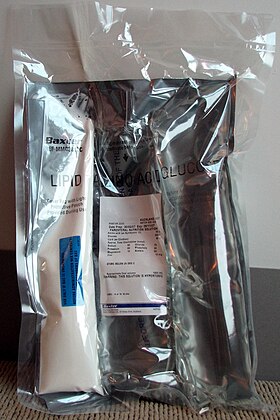
Back تغذية بالحقن Arabic Nutrició parenteral Catalan Parenterální výživa Czech Parenterale Ernährung German Nutrición parenteral Spanish Nutrizio parenteral Basque تغذیه وریدی Persian Nutrition parentérale French Beathú infhéitheach Irish הזנה תוך-ורידית HE
| Parenteral nutrition | |
|---|---|
 Home TPN formula |
Parenteral nutrition (PN), or intravenous feeding, is the feeding of nutritional products to a person intravenously,[1] bypassing the usual process of eating and digestion. The products are made by pharmaceutical compounding entities or standard pharmaceutical companies.[2][3] The person receives a nutritional mix according to a formula including glucose, salts, amino acids, lipids and vitamins and dietary minerals.[4] It is called total parenteral nutrition (TPN) or total nutrient admixture (TNA) when no significant nutrition is obtained by other routes, and partial parenteral nutrition (PPN) when nutrition is also partially enteric. It is called peripheral parenteral nutrition (PPN) when administered through vein access in a limb rather than through a central vein as in central venous nutrition (CVN).[5]
- ^ "BNFc is only available in the UK". NICE. Archived from the original on 2021-02-16. Retrieved 2021-02-19.
- ^ "Parenteral Manufacturing & Filling". Archived from the original on 28 November 2023. Retrieved 11 February 2024.
- ^ "Commercial Compounders". BSNA. Archived from the original on 2021-03-03. Retrieved 2021-02-19.
- ^ "Parenteral Nutrition: What it Is, Uses & Types". Cleveland Clinic. Archived from the original on 2023-10-26. Retrieved 2023-10-26.
- ^ Payne-James, J. Jason; Khawaja, Hamid T. (September 1993). "Review: First Choice for Total Parenteral Nutrition: The Peripheral Route". Journal of Parenteral and Enteral Nutrition. 17 (5): 468–478. doi:10.1177/0148607193017005468. PMID 8289417.